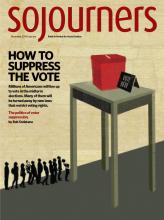MULTIRACIAL CHURCHES are becoming more common in this country—but that doesn’t happen by chance.
A 2010 study by the Hartford Institute for Religion Research, based on a random sample of more than 11,000 congregations, revealed an increase in multiracial congregations in the U.S.—30 percent of churches reported that more than half of their members were part of minority groups.
Members of three multiracial churches in and near the nation’s capital—one Catholic, one Methodist, and one nondenominational—say that at their church “people don’t look the same, or think that much about it,” and describe their congregations as welcoming places “where you can feel God’s presence, where you can be yourself.”
Though Sunday worship time is still known as “the most segregated hour in America,” older members of churches such as Peace Fellowship Church in Washington, D.C., St. Camillus Catholic Church in Silver Spring, Md., and Culmore United Methodist Church in Falls Church, Va., remember when things started changing. As migration and demographic shifts altered neighborhoods and communities, members sought to engage in “desegregated” worship, opting to join communities that mirrored a world with different cultures and ways to praise God.
Read the Full Article
